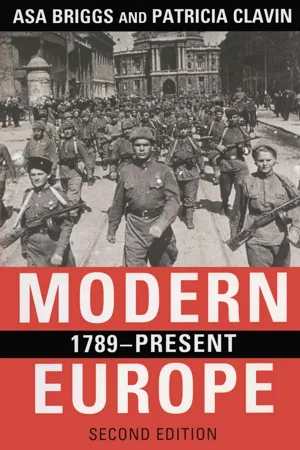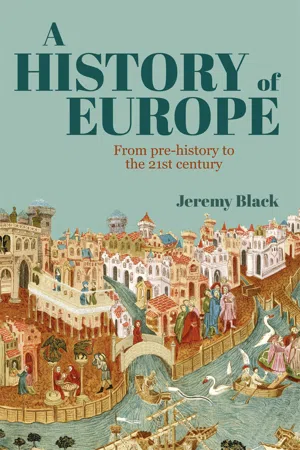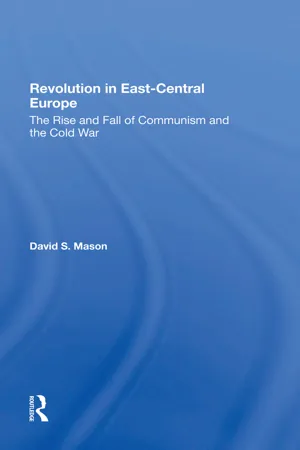History
Post War Europe
Post War Europe refers to the period following World War II, characterized by widespread destruction, economic recovery, and political realignment. The continent experienced significant social and cultural changes, including the emergence of new power dynamics and the division between Eastern and Western blocs. Post War Europe also saw the establishment of international organizations aimed at promoting peace and cooperation.
Written by Perlego with AI-assistance
Related key terms
4 Key excerpts on "Post War Europe"
- eBook - ePub
Experience and Memory
The Second World War in Europe
- Jörg Echternkamp, Stefan Martens(Authors)
- 2010(Publication Date)
- Berghahn Books(Publisher)
The Second World War ended in 1945; after that, a new chapter of history began. For decades, this was the manner in which the recent European past was conveniently classified. This chronological order can no longer be taken for granted, however, just as the concurrent complementary division of labor among historians is no longer self-evident. At least since 1989/90, the multilayered, mid- to long-term, in part still virulent effects of this “total” war in Western and Eastern Europe have become a focal point of public and academic interest. We have long come to realize how necessary and fruitful it is to break with the historiographical logic of the Cold War and its predetermined patterns of recognition and to – not least of all – examine the war's persistence in the postwar era more closely. This does not merely pertain to the material destruction. After victory or capitulation, farther reaching effects of the war prevented postwar societies from settling down: the demographic shifts, especially those brought about by flight and expulsion, but also the – sometimes forced – repatriation of displaced persons, the reintegration of the returning, sometimes invalid soldiers, and the resulting exacerbated problem of social assimilation – all these aspects play an important role. In addition, the new political order established in the rough climate of the East–West antagonism ensured that the Hot War was quickly succeeded by a Cold War.Rather than in retrospect constituting a prehistory to something new, the postwar period should primarily be regarded in this light, i.e., as a time that was decisively molded by the war's multifaceted effects. This period following the war is succinctly denoted by the concepts postwar era, Nachkrieg, l'après-guerre – terms whose semantics simultaneously allude to the war and its legacy. This reflects the seemingly paradoxical circumstance that the war did not end with the end of the war. The caesura of 8 May 1945 begins to lose its poignancy already when considering the developments in a single country more closely. Extending the vantage point to incorporate the historical experiences and perceptions of more than one country, it can even be quite misleading. The war ended at different points in time and its effects reached far beyond its end. The years of extreme passive and active experiences of violence threw long shadows, some of which even reach into the present.The postwar era was not least of all shaped by the manner in which the wartime was conveyed or hushed up. The tension between remembering and forgetting, the competition of different inclinations toward action and interpretation as consequences of the war, the possible discrepancy between personal, private recollections and official versions, especially in dictatorships – this is the conflict-laden presence of the past to which the wordplay “the war in the postwar era” alludes. This way of approaching the issue bears witness to the increased interest in the social, cultural, and military dynamics of the transformation phase between war and postwar era, as – for example – studied in France under the caption sorties de guerre.1 - eBook - ePub
- Asa Briggs, Patricia Clavin(Authors)
- 2014(Publication Date)
- Routledge(Publisher)
Chapter 10FREEZING AND THAWING POSTWAR EUROPE, 1945–1969
___________F or the people of Moscow peace officially began at 2 a.m. on the morning of 8 May 1945 when a salvo of a 1,000 guns was sounded. Some citizens cheered while others sobbed, recalling the loved ones who would never return. In London’s Trafalgar Square crowds lit fireworks, sang songs and embraced, and beneath the Arc de Triumph General de Gaulle solemnly saluted the tomb of the unknown soldier before euphoric men and women swept away the barriers surrounding the tomb in enthusiastic celebration. In Germany, by contrast, news of the defeat was met in dumb, apathetic silence, despite Allied fears that zealous young soldiers would be reluctant to surrender arms.For all of Europe, however, it did not take long for the pleasure of victory to be replaced by sobering recognition of the price to be paid for victors and vanquished alike. ‘This noble continent’, Winston Churchill proclaimed in neutral Switzerland in 1946, contained ‘a vast quivering mass of tormented, hungry, care-worn and bewildered human beings’ gaping at the ruins of their cities and scanning ‘the dark horizons for the approach of some new peril, tyranny or terror’. Definitions of Europe now took on an institutional dimension as organizations appeared on a European and global level, dedicated to fostering understanding and co-operation between nations on economic, social and political issues.Definitions of European geography changed too. Until the Cold War became the dominating feature of European life within three years of the Second World War, Europe was divided, as it was before 1939, into four distinct geographic regions: Northern Europe (Sweden, Denmark, Norway and Finland); Western Europe (including Ireland, Great Britain and France); Central Europe (including Germany, Italy, Greece, Austria, Hungary and Poland); and Eastern Europe (including Russia, the Ukraine and the Baltic states). Superpower rivalry and the political division of Europe in the Cold War changed all that. Central Europe effectively disappeared. Political alignment, not geography, determined that Northern Europe and, more particularly, large sections of Central Europe, notably Greece, Germany, Austria and Italy now all found themselves located in the West. - eBook - ePub
A History of Europe
From Pre-History to the 21st Century
- Jeremy Black(Author)
- 2021(Publication Date)
- Arcturus(Publisher)
Chapter 9
Post-War Europe
1945 to the presentThe threat of a nuclear conflict combined with a realignment of international politics, ideological division and the fear of repeating the events of the first half of the century led to a tense atmosphere during this period. Europe changed greatly as population growth, technological development, urbanization and a range of new cultural mores and environmental concerns made the continent a very different place.Changing Europe: The New Settlement
The peace settlement saw major territorial, demographic and political changes. The first two have substantially lasted to the present. With its forces in Berlin, Vienna, Budapest and Prague, the Soviet Union was a major winner. It retained all of the gains it had obtained in 1939–40 (from Poland, Romania and Finland, as well as the Baltic Republics in their entirety). The Soviet Union also added part of Czechoslovakia that had been annexed by Hungary in 1939, as well as the northern part of the German province of East Prussia.The (southern) remainder of East Prussia went to Poland, which also gained extensive German territories on its western frontier, namely Silesia and Eastern Pomerania. However, Poland lost more extensive territories (about 48 per cent of pre-war Poland) on its eastern frontier to the Soviet Union. This outcome reversed the Polish gains of 1920–1 and was rejected by the exiled Polish government. Today, as a result of the disintegration of the Soviet Union in 1991, these territories are parts of Belarus, Ukraine and Lithuania. Poland, in the meantime, had moved westwards as a country.Territories and cities were renamed accordingly. The German city of Breslau, where a long resistance to attacking Soviet forces had been mounted in 1945, became the Polish city of Wroclaw. Königsberg, the capital of East Prussia, became Kaliningrad, honouring a Soviet politician. Other names that entered the dustbin of history included Silesia, Pomerania and Stettin. - eBook - ePub
Revolution In East-central Europe
The Rise And Fall Of Communism And The Cold War
- David S Mason(Author)
- 2019(Publication Date)
- Routledge(Publisher)
FIVE The Postcommunist Era in International PoliticsThe collapse of communism in East-Central Europe not only revolutionized the societies of the region, but also revolutionized international politics. For four decades the international political environment was dominated by the Cold War and the conflict between communism and capitalism. Postwar U.S. foreign policy, throughout the ups and downs of U.S.-Soviet relations, was dictated by the containment of communism. An extended arms race between the Soviet Union and the United States led to the deployment by the superpowers of over 50,000 nuclear weapons, haunting the world with the specter of nuclear holocaust. Through most of the postwar period, U.S. military spending consumed about a quarter of the federal budget and reached $300 billion in the late 1980s. This drained money away from domestic needs and contributed to annual budget deficits of hundreds of billions of dollars and an accumulated national debt of over $3 trillion. In the Soviet Union, with a much smaller economy to begin with, the strain of defense spending was even greater.With the disappearance of the communist threat, so disappeared the rationale for containment and the basis of the Cold War. The events in East-Central Europe and the Soviet Union seemed to open up a new chapter in European history and world politics and to provide an opportunity to move beyond the tension and conflict of the postwar era. Even before the disappearance of the Soviet Union, Gorbachev spoke of global interdependence and the settling of disputes by diplomacy rather than arms. In the United States, there was discussion of an economic "peace dividend" and the possibility of construction of a "new world order." Much of this early euphoria disappeared with the massive U.S. military intervention in the Persian Gulf in early 1991 and the growing problems of nationalism and economic decay in the former Soviet Union and East-Central Europe. Nevertheless, a major transformation of world politics was under way, affecting Europe, East-West relations, the Third World, and the global political environment.
Learn about this page
Index pages curate the most relevant extracts from our library of academic textbooks. They’ve been created using an in-house natural language model (NLM), each adding context and meaning to key research topics.



